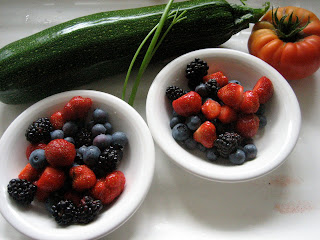Fruit trees are a great addition to a kitchen garden. There's nothing like smelling a peach ripen and picking it at the point of perfection. In Tacoma, we can grow many types of fruit trees. A good way to tell what will grow in your area is to visit a reputable local nursery in the late Winter. In February and March, the nurseries are fully stocked with bare root trees. My favorite local place to get fruit trees is Portland Avenue Nursery. They pot up the bare root trees in peat pots, so all you have to do is prepare your soil, cut slits in the pot, plant and stake it.
Things to Consider
Size
Fruit trees come in different sizes. Semi-Dwarf typically grows to around 15 feet tall. Dwarf is about 8 feet tall. This is controlled by the type of rootstock the tree is grafted onto. The top is the graft determines variety of fruit you're growing (e.g. 'Granny Smith' apple). The rootstock controls how large the tree will be. You will want to chose size according to the space you have. There are also trees available that are pruned for use in small spaces (e.g. espalier) and/or have multiple varieties grafted onto one tree (e.g. 3-way or 4-way combos). There are fruit trees that will grow fine in large pots (e.g. figs trees and Columnar apple trees).
Varieties
Varieties of each type of fruit have been selected by growers for their special characteristics. These can include flavor, disease resistance and hardiness. When you choose a variety of apple tree think about what you'll be using the apples for (e.g. baking, sauce or fresh eating). Most fruit tree labels will describe the virtues of the particular variety you're looking at.
Pollination
Certain types of fruit trees need two different varieties planted near each other for cross pollination to set fruit (i.e. "self-sterile"). Other types are "self-pollinating". Apple and pears are usually self-sterile while peaches are self-pollinating. This is good to know when planning out your space. If you have limited space you can buy a 3-way combo tree that has three varieties on one tree.
Pruning
Fruit trees have specialized pruning needs. I will address this at a later date.
Fertilizing
The most important thing to remember is that N (Nitrogen) is for leaf growth and P (Phosphorus) is for blooms. You want to use a balanced fertilizer or one specifically marketed for fruit trees. We give our trees a good dose of Phosphorus in the fall, so the trees will set buds for the Spring. If you give your trees way too much Nitrogen (like in lawn fertilizer) you'll have all leaves and no fruit.
Disease & Pests
Each type of fruit tree has its particular diseases and pests that it is susceptible to. Plant resistant varieties and know in advance what signs to look for. Sprays, traps, and barriers need to be deployed at the correct time to be effective.
Our garden
We have one peach tree, three apple trees and one nectarine tree. All of them are semi-dwarfs because we are using them for privacy screening for our window views as well. We have had mixed success with our efforts. Last year we had a bountiful crop of peaches and nectarines, but we have to be on constant look out for peach leaf curl (a fungal disease) and earwigs (they burrow into the peach pits as the peach ripens). This year the peach is doing great as usual, but the nectarine has lots of diseased branches that have died and a lot of leaf curl fungus.
Our apple trees have been frustrating. The first year we had a decent crop. The second year we had quite a few apple maggots in our apples. Last year we deployed several traps to catch apple maggots and coddling moths. We caught quite a few, but our apples were so heavily infested with maggots we threw the whole crop away. This year there was hardly any blooms on two of our trees.
If I had to do it all over again... I would have planted espalier fruit trees which are trained to grow flat for easy picking and taking up less space. I would be able to fit more types of trees in this way. I have seen espalier pear combo, cherry combo, apple combo, and asian pear combo trees. I love our Frost peach tree, so I'd keep that, but our nectarine is really diseased and I read that nectarines need a lot of spraying to keep them healthy.
Overall, it's really fun tending to our fruit trees. There's nothing like watching the buds open up in the Spring, seeing the bees pollinate the flowers, watching the fruit develop and ripen to perfection, finally picking it and tasting the fruits of our labor.
For more information about varieties check out the
Raintree Nursery catalog. Also Pierce County WSU Extension Master Gardeners can help with pest and disease identification.





















































